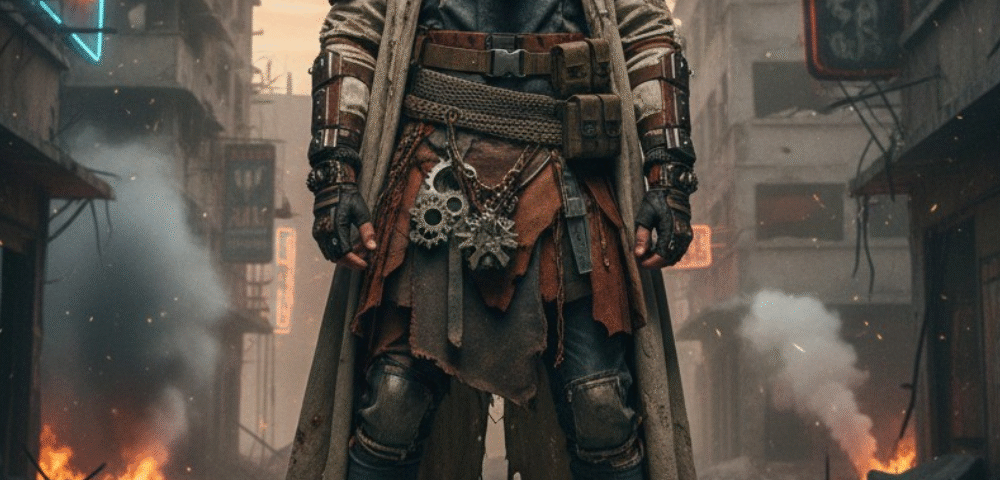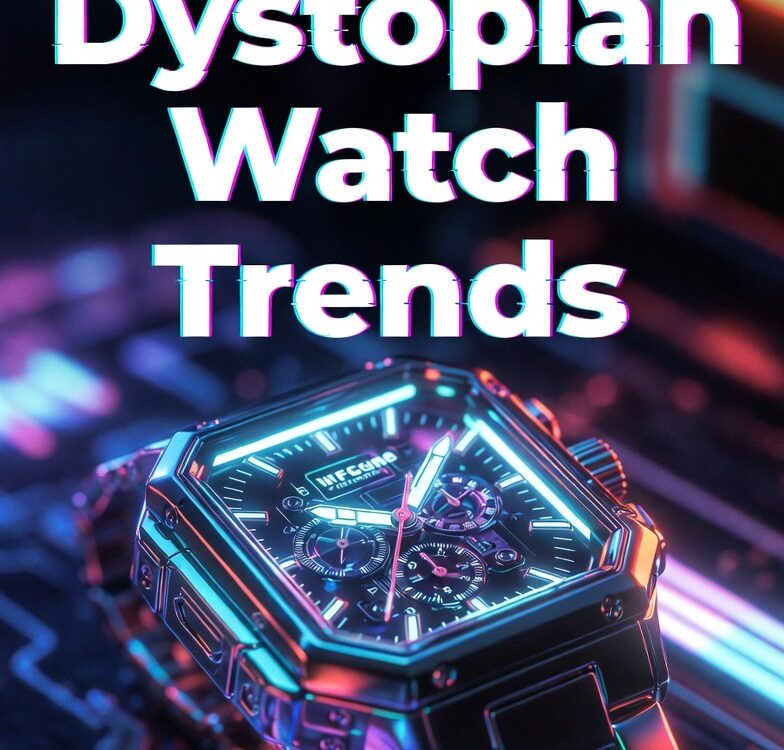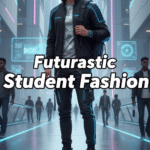
Futuristic Student Fashion: Embracing Tomorrow’s Trends on Campus
October 12, 2025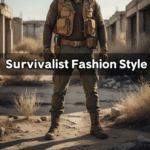
Embracing the Survivalist Fashion Style: Rugged, Ready, and Remarkably Stylish
October 13, 2025In a world increasingly shaped by uncertainty—climate change, technological upheaval, and global tensions—post-apocalyptic fashion has emerged as more than just a stylistic whim. It’s a bold statement of resilience, blending rugged utility with creative expression. From the dusty wastelands of cinematic blockbusters to the high-fashion runways of 2025, this aesthetic captures the imagination, offering a way to channel survivalist vibes into everyday wardrobes. Whether you’re drawn to distressed leather jackets or layered cargo pants, post-apocalyptic fashion invites us to rethink clothing as both armor and art. As we dive into its history, elements, and modern twists, discover how this trend is dominating wardrobes and reflecting our collective anxieties.
The Origins and Evolution of Post-Apocalyptic Fashion
Post-apocalyptic fashion didn’t spring up overnight; its roots trace back to the mid-20th century, fueled by Cold War fears and the rise of science fiction. Early influences came from literature like George Orwell’s 1984 and films such as A Clockwork Orange (1971), where costumes mixed punk rebellion with dystopian despair. By the 1980s, Japanese designers like Yohji Yamamoto and Rei Kawakubo of Comme des Garçons pioneered a “post-apocalyptic” look with deconstructed black garments, asymmetrical cuts, and an air of desolation. Their work, often in muted blacks and grays, echoed the aftermath of nuclear anxiety, blending minimalism with a sense of ruin.
The 1990s and early 2000s amplified this through pop culture. Iconic films like The Matrix (1999) introduced sleek, cyberpunk elements—think long trench coats and industrial boots—while Mad Max: Fury Road (2015) solidified the wasteland warrior aesthetic with fur-trimmed armor and sand-blasted fabrics. Video games such as Fallout and The Last of Us further popularized makeshift outfits, where characters scavenge for gear in ruined worlds. This evolution reflects societal shifts: from post-WWII reconstruction to today’s eco-conscious concerns, post-apocalyptic fashion has always mirrored real-world turmoil.
In recent years, the trend has surged amid global crises. The COVID-19 pandemic in 2020 saw a revival of “bleak, post-apocalyptic” styles, with designers like Marine Serre incorporating upcycled materials into futuristic collections. By 2025, it’s not just niche—it’s mainstream, appearing in luxury lines and streetwear alike.
Key Elements That Define Post-Apocalyptic Fashion
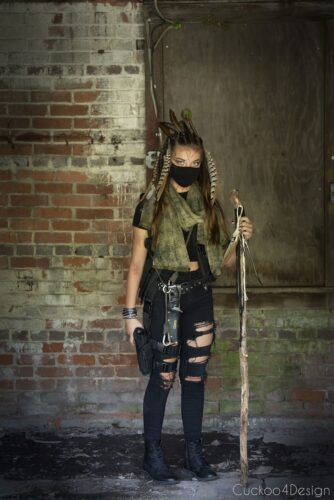
Credit: Pinterest
At its core, post-apocalyptic fashion prioritizes functionality over frivolity, creating looks that scream “survival chic.” One hallmark is distressed and deconstructed clothing: ripped jeans, frayed hems, and weathered fabrics that look like they’ve endured a nuclear winter. Layering is essential—think multiple shirts, vests, and scarves piled on for protection against imagined elements, often in earthy tones like khaki, olive, and rust to blend into desolate landscapes.
Accessories play a starring role, adding a tactical edge. Cargo pockets, harnesses, belts, and holsters aren’t just decorative; they’re practical for carrying “essentials” in a fictional apocalypse. Military-inspired boots, gas masks, and metal accents like spikes or chains evoke a battle-ready vibe. Fabrics lean toward durable materials: leather, canvas, and denim, often aged with sandpaper or tea stains for authenticity. The overall palette is muted—blacks, grays, and browns dominate, with occasional pops of metallic or neon for a cyberpunk twist.
This style’s versatility allows it to cross genres: from punk-rock rebellion to high-end couture, where designers like Rick Owens incorporate oversized silhouettes and raw edges. It’s about storytelling through clothes, where each tear or patch hints at a backstory of endurance.
Influences from Media and Pop Culture
Media has been the ultimate catalyst for post-apocalyptic fashion’s popularity. Films like the Mad Max series showcase nomadic styles with shoulder pads, goggles, and vehicle-part accessories, inspiring festivals like Wasteland Weekend. In The Hunger Games, Katniss Everdeen’s practical archery gear—braided hair, leather boots, and utilitarian jackets—brought dystopian style to mainstream audiences.
Television amplifies this: The Walking Dead features scavenged outfits with bloodstained shirts and bandoliers, while Blade Runner (1982) introduced rain-slicked trench coats and neon-lit collars that influence cyberpunk subcultures today. Pop culture events, from Comic-Con to Burning Man, turn these inspirations into real-life expressions, where attendees craft elaborate costumes blending sci-fi with streetwear.
Even music and art contribute—artists like Billie Eilish have sported oversized, distressed looks that nod to apocalyptic themes, making the style accessible to younger generations. This cross-pollination keeps post-apocalyptic fashion fresh and culturally relevant.
Post-Apocalyptic Fashion Trends in 2025
As we hit 2025, post-apocalyptic fashion is hitting new heights on runways and in street style. Designers are fusing dystopian elements with luxury, like Vollebak’s “apocalypse-ready” jackets made from indestructible materials. Events like Wasteland Weekend 2025 highlight trends such as techwear harem pants with cargo pockets and barbarian-inspired fur skirts.
Sustainability is key, with brands using recycled plastics and upcycled military surplus for eco-friendly twists. Look for muted earth tones, deconstructed layers, and utility gear in collections from emerging labels like Carzana, which evoke a return to primitive fabrics in a high-tech world. Streetwear adapts this with ripped harem pants and oversized boots, proving the trend’s adaptability from festivals to urban settings.
DIY Ideas for Creating Your Own Post-Apocalyptic Look
Embracing post-apocalyptic fashion doesn’t require a designer budget—DIY is at its heart. Start with thrifted clothes: take old jeans and distress them using sandpaper on knees and hems for a worn-in feel. Add rips with scissors, then “age” fabrics by soaking in tea or coffee for stains.
Layer up: Pair a tactical vest over a ripped shirt, adding belts and holsters from army surplus stores. For accessories, craft shoulder pads from foam or old tires, and incorporate feathers or chains for a tribal edge. Footwear? Combat boots scuffed with dirt complete the ensemble.
For women, try a post-apocalypse warrior vibe with ripped leggings, a military scarf, and a black vest. Men can opt for cargo pants with patched knees and a hooded jacket. The key is imperfection—embrace asymmetry and personalization to make it your own.
The Sustainable Side of Post-Apocalyptic Fashion
Ironically, a style born from destruction champions sustainability. Many pieces use upcycled materials, like repurposed rubber or ocean plastics, reducing waste. Designers like Marine Serre focus on recycled fabrics, aligning with eco-trends.
This aesthetic promotes longevity—durable items meant to “survive” encourage less consumption. In a climate-crisis era, post-apocalyptic fashion reminds us to rethink fast fashion, favoring quality over quantity. It’s a forward-thinking approach, blending style with environmental responsibility.
FAQs About Post-Apocalyptic Fashion
What is post-apocalyptic fashion?
Post-apocalyptic fashion is a style inspired by dystopian scenarios, featuring distressed, layered clothing with utilitarian elements like cargo pockets and rugged fabrics.
How can I incorporate post-apocalyptic fashion into my daily wardrobe?
Start small: Add a distressed jacket or combat boots to casual outfits. Layer neutrals and accessorize with belts for an edgy twist without going full wasteland.
Is post-apocalyptic fashion sustainable?
Yes, it often uses upcycled and recycled materials, promoting eco-friendly practices by repurposing items that might otherwise end up in landfills.
What media has influenced post-apocalyptic fashion the most?
Films like Mad Max and Blade Runner, along with games like Fallout, have shaped the look with their survivalist costumes.
Can post-apocalyptic fashion be worn in professional settings?
Absolutely—tone it down with subtle elements like a leather belt or muted cargo pants paired with a blazer for a modern, edgy professional vibe.
Where can I buy post-apocalyptic fashion items?
Look at brands like Vollebak for luxury pieces, or thrift stores and online shops like Etsy for DIY-inspired gear.
Final Words
Post-apocalyptic fashion isn’t just about dressing for the end of the world—it’s about embracing resilience, creativity, and sustainability in uncertain times. From its roots in sci-fi to its 2025 runway dominance, this trend empowers us to turn chaos into style. Whether you’re DIY-ing a look or splurging on luxury survival gear, remember: in the wasteland of fashion, the bold survive. Channel your inner warrior and make it your own—after all, style is the ultimate form of adaptation.


